
Gian LorenzoBernini was an Italian sculptor and architect. While a major figure in the world of architecture, he was more prominently the leading sculptor of his age, credited with creating the Baroque style of sculpture.

Charles Perrault was a French author and member of the Académie Française. He laid the foundations for a new literary genre, the fairy tale, with his works derived from earlier folk tales, published in his 1697 book Histoires ou contes du temps passé. The best known of his tales include "Le Petit Chaperon Rouge", "Cendrillon" ("Cinderella"), "Le Maître chat ou le Chat botté", "La Belle au bois dormant", and "Barbe Bleue" ("Bluebeard").

François Girardon was a French sculptor of the Louis XIV style or French Baroque, best known for his statues and busts of Louis XIV and for his statuary in the gardens of the Palace of Versailles.
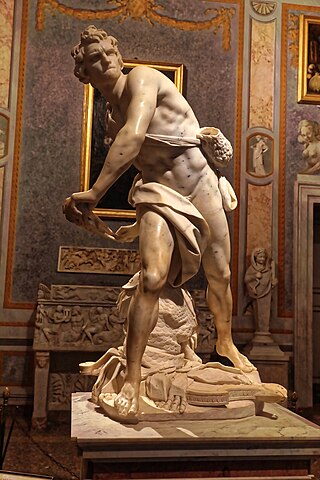
David is a life-size marble sculpture by Gian Lorenzo Bernini. The sculpture was one of many commissions to decorate the villa of Bernini's patron Cardinal Scipione Borghese – where it still resides today, as part of the Galleria Borghese. It was completed in the course of eight months from 1623 to 1624.

François Duquesnoy or Frans Duquesnoy was a Flemish Baroque sculptor who was active in Rome for most of his career, where he was known as Il Fiammingo. His idealized representations represented a quieter and more restrained version of Italian baroque sculpture, and are often contrasted with the more dramatic and emotional character of Bernini's works, while his style shows a great affinity to Algardi's sculptures.

Francesco Mochi was an Italian early-Baroque sculptor active mostly in Rome, Piacenza and Orvieto. His dramatic early works in Orvieto are now often regarded as the first truly Baroque sculptures.
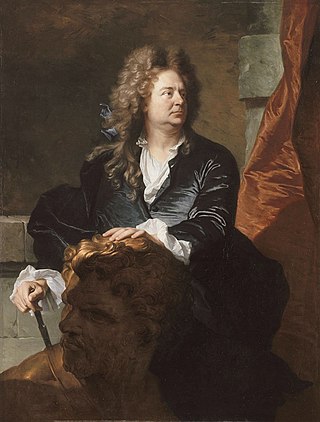
Martin Desjardins, born Martin van den Bogaert was a French sculptor and stuccoist of Dutch birth.
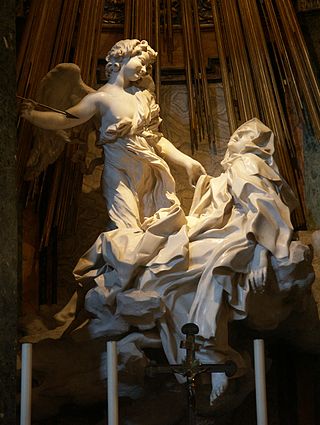
Baroque sculpture is the sculpture associated with the Baroque style of the period between the early 17th and mid 18th centuries. In Baroque sculpture, groups of figures assumed new importance, and there was a dynamic movement and energy of human forms—they spiralled around an empty central vortex, or reached outwards into the surrounding space. Baroque sculpture often had multiple ideal viewing angles, and reflected a general continuation of the Renaissance move away from the relief to sculpture created in the round, and designed to be placed in the middle of a large space—elaborate fountains such as Gian Lorenzo Bernini‘s Fontana dei Quattro Fiumi, or those in the Gardens of Versailles were a Baroque speciality. The Baroque style was perfectly suited to sculpture, with Bernini the dominating figure of the age in works such as The Ecstasy of St Theresa (1647–1652). Much Baroque sculpture added extra-sculptural elements, for example, concealed lighting, or water fountains, or fused sculpture and architecture to create a transformative experience for the viewer. Artists saw themselves as in the classical tradition, but admired Hellenistic and later Roman sculpture, rather than that of the more "Classical" periods as they are seen today.

The Rape of Proserpina, more accurately translated as the Abduction of Proserpina, is a large Baroque marble group sculpture by Italian artist Gian Lorenzo Bernini, executed between 1621 and 1622, when Bernini's career was in its early stage. The group, finished when Bernini was just 23 years old, depicts the abduction of Proserpina, who is seized and taken to the underworld by the god Pluto. It features Pluto holding Proserpina aloft, and a Cerberus to symbolize the border into the underworld that Pluto carries Proserpina into.
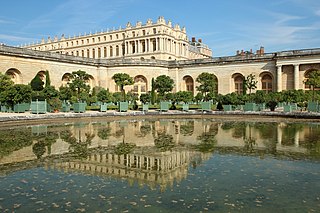
The Versailles Orangerie was built by Jules Hardouin-Mansart between 1684 and 1686, before work on the Château de Versailles had even begun. The Orangerie, which replaced Louis Le Vau's earlier design from 1663, is an example of many such prestigious extensions of grand gardens in Europe designed both to shelter tender plants and impress visitors. With the addition of the Orangerie, the gardens, no longer reserved solely for use by Louis XIV, had the added use of a theatrical setting that could be used to entertain guests at court.

The Martyrdom of Saint Lawrence is an early sculpture by the Italian artist Gian Lorenzo Bernini. It shows the saint at the moment of his martyrdom, being burnt alive on a gridiron. According to Bernini's biographer, Filippo Baldinucci, the sculpture was completed when Bernini was 15 years old, implying that it was finished in the year 1614. Other historians have dated the sculpture between 1615 and 1618. A date of 1617 seems most likely. It is less than life-size in dimensions, measuring 108 by 66 cm.
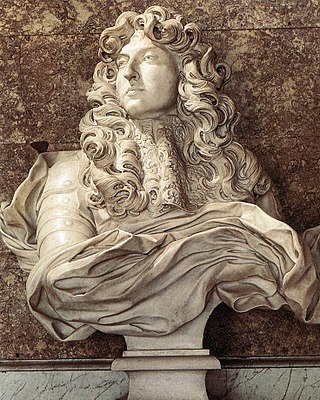
The Bust of Louis XIV is a marble portrait by the Italian artist Gian Lorenzo Bernini. It was created in the year 1665 during Bernini's visit to Paris. This sculptural portrait of Louis XIV of France has been called the "grandest piece of portraiture of the Baroque age". The bust is on display at the Versailles Palace, in the Salon de Diane in the King's Grand Apartment.

Medusa is a marble sculpture of the eponymous character from the classical myth. It was executed by the Italian sculptor Gian Lorenzo Bernini. Its precise date of creation is unknown, but it is likely to have been executed in the 1640s. It was first documented in 1731 when presented to the Palazzo dei Conservatori in Rome, and is now part of the collections of the Capitoline Museums.

The Bust of Costanza Bonarelli is a marble statue bust created by Gian Lorenzo Bernini during the 1630's. The piece is currently being shown in the Museo Nazionale del Bargello in Florence, Italy. Considered among the most personal of Bernini's works, the bust shows a figure named Costanza Piccolomini Bonarelli, the wife of Matteo Bonarelli, and one of Bernini's disciples and colleagues.

The Vision of Constantine is an equestrian sculpture by the Italian artist Gian Lorenzo Bernini, located in the Scala Regia by St. Peter's Basilica in Vatican City. Originally commissioned as a free standing work of art within St. Peter's itself, the sculpture was finally unveiled in 1670 as an integral part of the Scala Regia - Bernini's redesigned stairway between St. Peter's Basilica and the Vatican Palace. Unlike other large works by Bernini, art historians have suggested that this work was almost entirely undertaken by him - no other sculptors have been recorded as receiving payment. Bernini's overall fee was 7,000 Roman scudi.
The Bust of Cardinal Giovanni Dolfin or Delfin is a sculptural portrait by the Italian artist Gian Lorenzo Bernini, which is part of a mausoleum for the Venetian Cardinal Giovanni Delfin, member of one of Venice's most ancient noble families. The tomb as a whole was a joint work commissioned of Bernini and his father Pietro. While Gianlorenzo executed the portrait bust, Pietro carried out the surrounding figures, including two allegorical figures of Faith and Hope as well as the Delfin family coat of arms. The work was completed in late 1621, and sits in the church of San Michele in Isola.

The Raimondi Chapel is a chapel within the church of San Pietro in Montorio, Rome, Italy. The chapel houses the tombs of two members of the Raimondi family, Francesco and Raimondo. Both the architectural and sculptural elements of the chapel were designed by the artist Gianlorenzo Bernini - it was one of Bernini's first works where the relationship between the sculpture and the architecture was considered as a whole. Elements of the sculptures were executed by other artists in Bernini's circle; Andrea Bolgi did the busts of the two Raimondi brothers and the accompanying putti. Niccolò Sale undertook the reliefs on the tombs, while Francesco Baratta did the larger relief in the central altar. Work on the chapel took place between 1638 and 1648.

Irving Lavin was an art historian of Late Antique, Medieval, Renaissance, Baroque, and Modern painting, sculpture, and architecture. His wide-ranging contributions centered primarily on the correlation between form and meaning in the visual arts.

The Louis XIV style or Louis Quatorze, also called French classicism, was the style of architecture and decorative arts intended to glorify King Louis XIV and his reign. It featured majesty, harmony and regularity. It became the official style during the reign of Louis XIV (1643–1715), imposed upon artists by the newly established Académie royale de peinture et de sculpture and the Académie royale d'architecture. It had an important influence upon the architecture of other European monarchs, from Frederick the Great of Prussia to Peter the Great of Russia. Major architects of the period included François Mansart, Jules Hardouin-Mansart, Robert de Cotte, Pierre Le Muet, Claude Perrault, and Louis Le Vau. Major monuments included the Palace of Versailles, the Grand Trianon at Versailles, and the Church of Les Invalides (1675–1691).

The Saint Andrew is a larger-than-life marble sculpture by Flemish artist François Duquesnoy, executed between 1629 and 1633. Located in the crossing of Saint Peter Basilica in Rome, the work depicts Andrew the Apostle leaning over the crux decussata of his martyrdom. Duquesnoy's St Andrew is one of four colossal statues beneath the dome of St. Peter, standing opposite to Bernini's less restrained Saint Longinus. The four colossi were installed in niches within the four piers supporting the dome between 1639 and 1640.





















